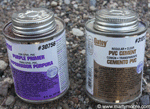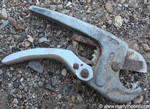This installation information is intended for the homeowner who wants to save some money and install their own sprinkler system. These are VERY basic and simple instructions.
Large or small sprinklers...
If your lawn area is small, you can go strickly with small pop-up sprinklers. Pop-up sprinklers have a maximum spraying distance of about 15 feet, but it can be less with a simple adjustment.
If the lawn area is fairly large, you can use oscillating or gear-driven sprinklers. They have a longer spraying distance, 15 to 65 feet. Normal residential spacing is 25 or 35 feet apart.
It is best not to mix the two types on one station. Pop-ups may need to be on for only 15 minutes at a time, while oscillating or gear-driven sprinklers may need an hour. Watering times will depend on your specific soil and plant requirements.
How many sprinklers...
Determine how many sprinklers you can have on one station. You will need to know your water PSI (pounds per sqare inch), and the best way to find out is either with a pressure gauge or by calling your local water supplier and asking them.
Small pop-up sprinklers need between 20 and 30 PSI to work properly. Gear-driven need 30 PSI or more to work well. If your pressure is low you will need to place the sprinklers closer together to compensate or put fewer sprinklers on each valve. Discussing PSI and GPM is a much larger topic than can be covered on this page, but we will address it in a future article.
The simplist way to find out how many sprinklers you can have on one station or valve is to call your local irrigation supply company and tell them your water's PSI, what kind of sprinkler you are intending on using and what size pipe. There is a formula for this and they should be able to help you figure it out.
Timers...
Choose the area you want to install the irrigation timer. Either indoors, say in a garage or outside on a wall of the house. The timer will need electricity so if you don't want to call an electrician to hook it up for you, opt for the indoor timer and position it near an electrical outlet.
Choose an area for the valve box, the closer it is to the timer, the less wire you will need. You also need access to your house water line.
Sprinkler placement...
Sprinklers should go in all corners and at the same distance one from another, with head-to-head coverage. That means that if you have a sprinkler that shoots water 15 feet, you will position the next sprinkler where it's spray pattern hits the other sprinkler, or 7.5 feet apart.
You don't want dry spots so we suggest spacing them a little closer than the suggested spray distance.
Trenches...
OK, now you can plan out your pipe lines and dig the trenches. Trenchers can be rented at your local equipment store or if you are really ambitious, you can dig, dig, dig.
Your trench depth will depend on the type of sprinkler you are using, large sprinklers need at least an 18 inch deep trench and small pop-up sprinklers will need less. The body size of the small sprinkler you choose will determine the trench depth, they come in 3, 4, 6 and 12 inch body lengths. We usually stick to the 4 inch size.
Make your trenches at 90 degree angles, PVC pipe will bend a little, but making them as close to 90 degrees as possible is best.
Dig a good size hole for the manifold/valve box.
After your trenches are dug, lay out all your piping, and place sprinklers at proper distances apart. Beside each sprinkler, also place the necessary fittings, T's or elbows and risers. See picture.
It is best to use schedule 40 PVC pipe, as it is much stronger than schedule 20. Most home sprinkler systems use one inch pipe, so that is what we will discuss using here.
Pipe and fittings...
Always use both primer and glue at each fitting. Primer removes the slick coating on the PVC fitting, making the glue adhere better.
Using a pipe cutter is the best way to go, the cut is clean and fast compared to using a hacksaw.
Start at one corner
and glue a one inch elbow with a 1/2 inch threaded end onto the one inch pipe and screw a cut-off riser into the 1/2 inch fitting.
Don't attach the sprinklers yet!
Keep going down the pipe attaching one inch slip by 1/2 inch threaded T's and risers until you reach the manifold box. If, because of your PSI, you can only have 10 sprinklers on one valve and you need a total of 40 sprinklers, you will have 4 valves in your manifold box.
Valves...
Some landscapers use a master valve before all the other valves but we found that the master valve tended to "go bad" sooner than the other valves since it had more use than the others and if it goes bad, none of the others will work.
The whole landscape relies on the master valve working, but if you don't use one, each valve is seperate and if one goes bad, it will not affect the others.
On the other hand if one valve gets stuck it will run forever without a master valve to shut it off. The choice is up to you, whether you use a master valve or not.
After you have all the lateral pipe lines ending at the manifold box, you can now attach each pipe to a valve. A picture of this configuration will be added soon.
Now connect all the valves together creating a manifold.
AVB's and PVB's...
Tee into your house water line and add a PVB, pressure vacuum breaker, or if the system has only one valve an AVB, atmospheric vacuum breaker. Connect the vacuum breaker to the valve manifold.
Some landscapers will use several AVB's, one for every valve, this looks horrible and you should insist they use one PVB. The PVB's are required to be 12 inches above grade where ever you install them, but the AVB must be 12 inches above the highest point in the system.
We have seen AVB's three feet in the air, this not only looks bad, but they are vulnerable to breaking off and think about it, they are under constant pressure. These landscapers only do it that way to save some money, as the AVB's are very inexpensive. Don't let them get away with that.
Wiring the timer...
Run sprinkler wire from the timer to the valves. Sprinkler or irrigation wire consists of several color-coded wires all wrapped together in one wire. Let's say you have four valves, you then need four different colored wires and one common wire, usually white is used for the common wire. Connect the four wires in the timer box, one for each station and the common wire in the area marked "C" for common.
Attach each of the four wires, to one of the wires on each valve's solenoid. Run the white wire from the timer down to the valves and attach each solenoid's other wire to the white wire. Therefore all the solinoids are connected together by the white wire.
Test the system...
Your trenches should be open with risers sticking up. Open each valve manually, either with the solenoid or the bleed valve and run the water until it runs clean, no dirt in the lines. Do this to all of the lines and then cut the risers off to a length that will accompdate the sprinkler. Remember to take in to account the level of the finished grass.
Attach the sprinklers and test the system using the timer, if you did everything correctly, you should be very happy, you now have a great, inexpensive, self-installed, working sprinkler system!
These are only basic instructions and more detailed pieces will be added soon.
We will be discussing the repairing of valves, sprinklers and pipes, adjusting sprinklers, adding bubbler lines, drip lines and lots more, so please check back.


1.gif)
2.gif)
1.gif)




